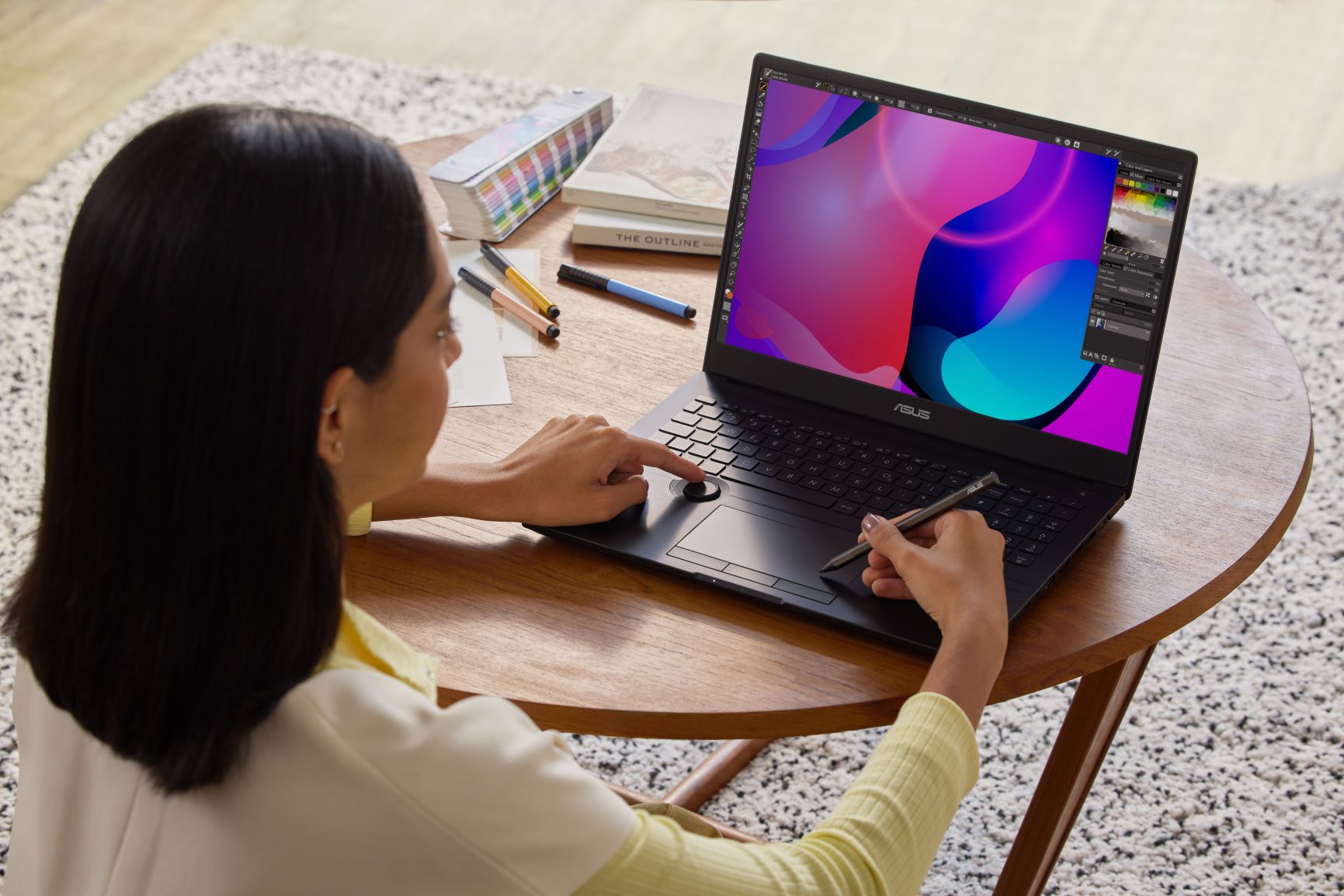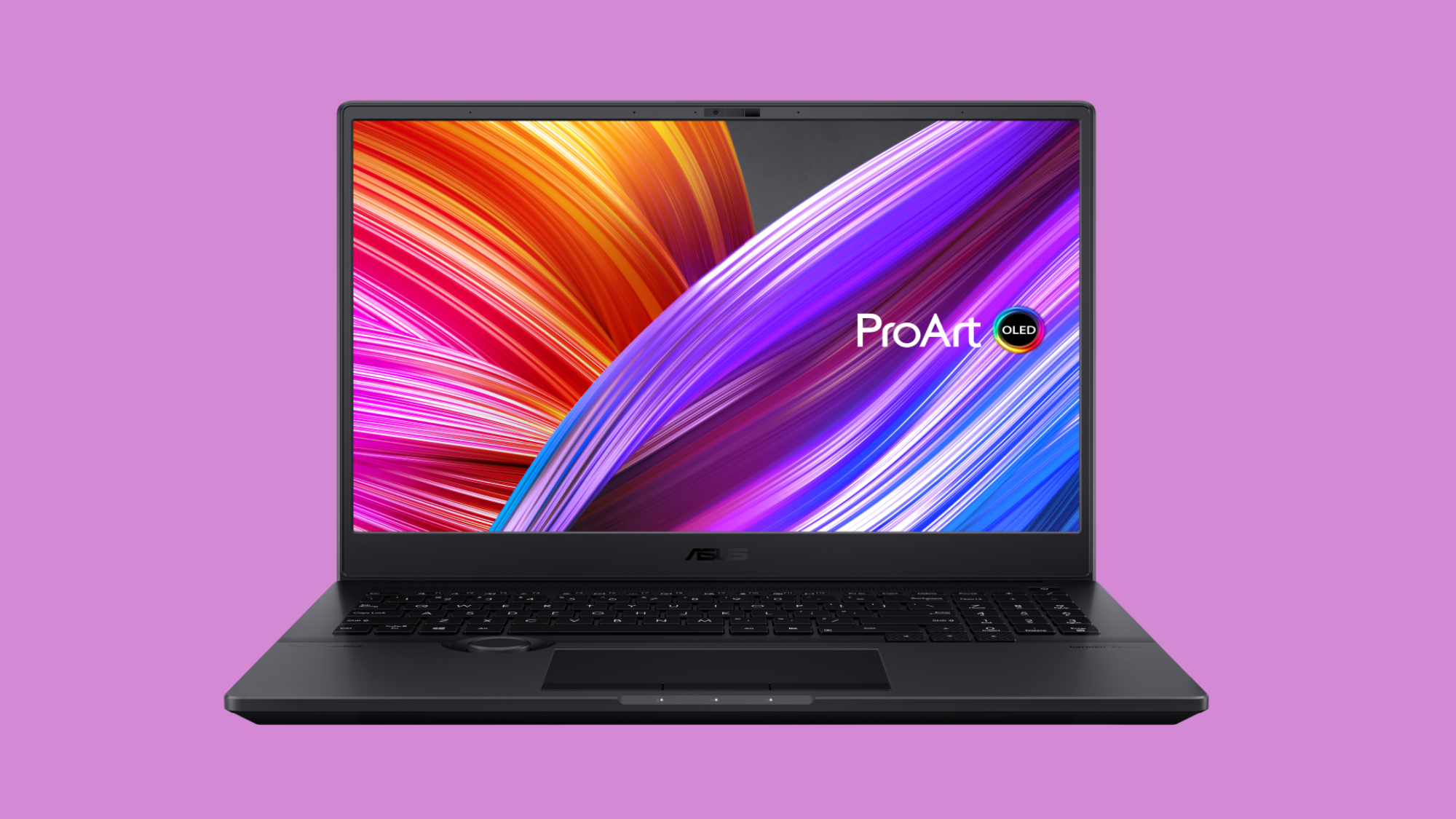New Asus ProArt Studiobook 16 arrives with a funky dial and a touchpad that doubles as a drawing board
Asus dials up the fun with a funky new keyboard feature

Asus took its time to reflect on the granular needs of professional content creators with the new ProArt Studiobook 16. Yes, creator-targeted laptops must be configured with discrete graphics and high-performing processors that can handle video editing, photo retouching and more. But what about you as the artist? Shouldn't laptops optimize and streamline your workflow?
That's why Asus implemented a cool new feature in the ProArt Studiobook 16: the Asus Dial. It's a physical rotary control embedded in the deck that lets users manipulate nitty-gritty details on select Adobe apps. Another striking aspect of the Studiobook is the world's first 16-inch, 4K OLED, HDR display with a 16:10 aspect ratio. The eye-catching offerings don't stop there, though. Here's everything the Studiobook has to offer.
- Asus ProArt StudioBook 15 review
- Best laptops for video editing in 2021
The Asus ProArt Studiobook 16
The Asus ProArt Studiobook 16 can either be configured with an Intel Core i7 CPU or an AMD Ryzen 5000 H-series processor. The former is equipped with Nvidia RTX 3060 graphics while the latter features an Nvidia RTX 3070 GPU. Both have a starting price tag of $1,999.

The AMD and Intel-packed models come with dual, ultra-fast PCIe SSDs and up to 64 GB of RAM.
Display
Whether you choose AMD or Intel, you'll likely be amazed by the ProArt Studiobook 16's screen. As mentioned, the Studiobook features the world’s first 16-inch, 4K OLED, HDR display.

Asus boasts that the display is factory-calibrated to meet Pantone-validated, color-accuracy standards. The panel is also Calman-verified. The Taiwan-based company says that the display covers 100% of the DCI-P3 color gamut, calling it a "cinema-grade" panel. An ultra-vivid, color-accurate display is an ideal feature for photo and video editors; we can't wait to test the panel ourselves to corroborate Asus' claims.
Ports
If you're wondering about ports, the ProArt Studiobook 16 is generous with its I/O options, offering two USB 3.2 Gen 2 Type-A ports, an SD Express 7.0 card reader, an Ethernet RJ45 port, a headset jack, a security lock slot and HDMI 2.1, which can support output of up to 8K at 120Hz or 10K at 60Hz.
Sign up to receive The Snapshot, a free special dispatch from Laptop Mag, in your inbox.
One difference is that the AMD model has two USB 3.2 Gen 2 Type-C ports. The Intel configuration also has two Type-C ports, but one of them is Thunderbolt 4.
Asus Dial
As mentioned at the outset, the Asus Dial is a fascinating new rotary mechanism that gives you instant and precise control over specific parameters within compatible Adobe creative apps. Let’s say, for example, you want to decrease the saturation on Photoshop, Asus Dial lets you fine-tune your settings down to infinitesimal tweaks.

There are over 70 functions available on the Dial, and it’s currently available with Adobe Photoshop, Lightroom Classic, Premiere Pro and After Effects. The Dial may be especially helpful for producers who need to progress through video timelines by mere milliseconds. Here’s a non-exhaustive list of other functions you can add to the dial:
- Color balance and tone
- Time axis adjustment
- Brush smoothing modification
- Undo
- Redo
- Lasso
- Opacity
- Exposure
- Zoom in and out
You can also use the Dial during non-creative workflows. For example, you can use it to manage volume and brightness.
Some of you may be thinking, “The Dial is awkwardly placed on the palm rest. Doesn’t it get in the way?” According to Asus, it doesn't. The Dial is recessed into the laptop and sits flush against the deck.

Touchpad with stylus support
The touchpad on the ProArt StudioBook 16 is no ordinary touchpad. Yes, it can sense your touch gestures, but it can also register stylus inputs. It’s like having a small, digital drawing board built right into the deck. It’s also worth noting that the touchpad has three buttons (as opposed to two). The extra button — located in the middle — is ideal for 3D artists. It gives them easy access to special functions such as panning, rotating and orbiting to view their creations from different angles and perspectives. Simply press and hold the middle button and use the touchpad to rotate your 3D artifacts.
Asus ProArt Studiobook PRO 16
The Studiobook 16 is best for professionals who often work on programs like Adobe Premiere, Photoshop, After Effects, Lightroom, Illustrator and InDesign, as well as DaVinci Resolve, Blender and more. However, if you’re an architect or engineer who uses CAD modeling apps, or a data scientist who works with AI and Big Data programs, you may want to redirect your attention to the Asus ProArt Studiobook Pro 16.
The Asus ProArt Studiobook Pro 16 is powered by an AMD Ryzen 5000 H-series processor or a 3rd-Gen Intel Xeon workstation CPU, which can handle ultra-complex, heavily multi-threaded photorealistic rendering, visualization, simulation or analysis applications. The ProArt Studiobook Pro 16 starts at $2,499.99.
Outlook
Asus didn't announce an official release date for the Studiobook 16 nor the Pro models, but the Taiwan-based company said that it should hit store shelves by Q4 of 2021.
We're curious to see whether the funky Asus Dial is truly useful for creative professionals. Stay tuned for our review of the AMD-equipped Studiobook 16. We'll have benchmarks, battery life results and more to help you determine whether this laptop is for you.
Kimberly Gedeon, holding a Master's degree in International Journalism, launched her career as a journalist for MadameNoire's business beat in 2013. She loved translating stuffy stories about the economy, personal finance and investing into digestible, easy-to-understand, entertaining stories for young women of color. During her time on the business beat, she discovered her passion for tech as she dove into articles about tech entrepreneurship, the Consumer Electronics Show (CES) and the latest tablets. After eight years of freelancing, dabbling in a myriad of beats, she's finally found a home at Laptop Mag that accepts her as the crypto-addicted, virtual reality-loving, investing-focused, tech-fascinated nerd she is. Woot!

